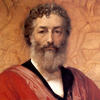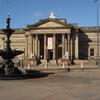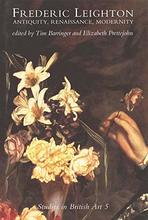More about Elijah in the Wilderness
- All
- Info
- Shop

Contributor
Leighton's Elijah in the Wilderness shows a miraculous scene from the Book of I Kings, chapter 19, verses 4-7.
The prophet and folk hero Eliyahu ha-Navi, known in Western translation as "Elijah," is stranded way out in the desert, somewhere in Judah, with no cell phone, no car, and the buses aren't running. Suddenly, an angel appears to give Elijah food and water in his moment of desperation. How did he end up in this situation? It turns out he came out here running from Jezebel, Daughter of Ethbaal, King of Sidon, and wife of Ahab, the second king of the fourth dynasty of Israel, with whom he had a little, or maybe not so little, disagreement as to whether the Jews should praise Baal or their own god.
Elijah's unusual appearance in the written Torah, like that of Melchizedek, was without parents, so some Kabbalistic traditions state that he's an angel in human form or a supernatural mediator with more free will than angels, suggesting that his foray into the wilderness and reliance on the angel was all a kind of divinely-ordained role-playing game, with the intention of convincing humans that he was a regular person, just like them.
This work was commissioned by Andrew Kurtz, heir of the chemical factory Sutton Alkali Works, for the opening of Liverpool's Walker Art Gallery. Leighton lived in a customized artist's house, with only one bedroom but a vast studio and gallery, which is open to the public today. The simultaneously monastic and opulent character of the house impressed Kurtz, who said that Leighton "lives in the beautiful which is a necessity of his existence." When Kurtz purchased this work, along with two others, after reviewing Leighton's preliminary sketches, he dropped the equivalent of more than $1.25 million in today's money. He wrote in his diary, "I don’t know what craze seizes me where pictures are concerned but I seem to buy wildly regardless of consequences; I must try to be more cautious."
Leighton's friend, the novelist Emilie Isabel Barrington, said, of this work, that the artist "had put more of himself into the picture than in to any other he had invented." A few critics attacked the work, saying that it was the brilliant but excessively academic product of a man whose heart was "dormant." Suddenly, the critics no longer wanted academic correctness. Another critic praised its color scheme and "vigor." Kurtz wrote that Leighton's work was "wanting in masculine force," but that, nonetheless, he was a "great painter and should be an object of interest to people now long unborn."
Sources
- Barrington, Emilie Isabel. The life, letters and work of Frederic Leighton. London: Allen, 1906.
- Peter Betts, "Elijah in the Wilderness," National Museums Liverpool, https://www.liverpoolmuseums.org.uk/transcript-of-elijah-wilderness-pod….
- The Chemical Trade Journal, Volume 6. Manchester, 1890.
- Corkran, Alice. Frederic Leighton. London: Methuen & Company, 1904.
- Denis, Rafael Cardoso, and Colin Trodd. Art and the Academy in the Nineteenth Century. Manchester: Manchester University Press, 2000.
- Lindbeck, Kristen H. Elijah and the Rabbis: Story and Theology. New York: Columbia University Press, 2010.
- Staley, Edgcumbe. Lord Leighton of Stretton: P. R. A. London: Walter Scott, 1906.












